For decades, the Stanley cup company primarily focused on only one target market: working men.
Then, in January 2024, women lined up for hours to buy a Target-exclusive pink cup. Kid were upset if they didn’t get Stanleys at Christmas like all their trendy school friends. And everywhere on social media (on TikTok in particular), people were showing off their precious, $60-something tumblers as if they were Oscar statues.
If the story of Stanley’s meteoric shift in target market teaches us anything, it’s that you need to know who your audience is. More specifically, you need to know their age, their gender, their level of income, and other insights to create personalized marketing campaigns.
Fortunately, there’s a marketing strategy for researching and organizing this data. It’s called demographic segmentation.
What is Demographic Segmentation in Marketing?
Demographic segmentation is part of audience segmentation and is a fairly easy concept to grasp.
All you’re doing is looking for patterns of characteristics in your audience to find out who your biggest target markets are.
Collectively, these characteristics are called demographics.
When we perform demographic segmentation in marketing, we’re grouping members of our audience who share the same characteristics.
Think of it like sorting through a bag of Halloween candy. You decide to organize them by type, so you put lollipops in one pile, chocolates in another pile, and so on. This way, we can see which type we received the most.
Once we start grouping audience members by their specific demographics, we can often find points where multiple groups intersect.
For example, if we were to analyze Stanley’s new target market research, we would likely find that their largest demographic is 25-50-year-old women.
That’s like sorting candies by types, and then further segmenting those types by color. This enables us to see which candy and which color of that candy had the largest quantity in the bag.
Types of Demographic Segmentation
At this point, you may be wondering what characteristics we’re looking for during demographic segmentation.
Demographic data is a broad term with a very basic definition: the facts about a person that you can observe objectively or that describe their life. These facts include:
- A person’s age (or their approximate age range)
- Their gender/sexuality
- Their race/ethnicity
- Their occupation and level of income
- Their religion
- Their level of education
- Their marital status
- Their family structure
- Their geographic location
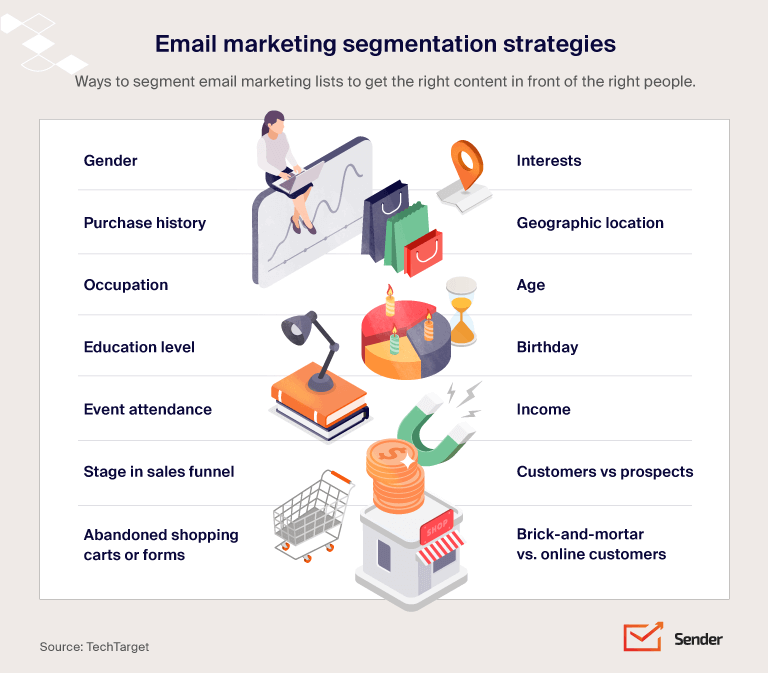
Why is Demographic Segmentation in Marketing So Important?
Let’s go over the key demographic segmentation benefits to find the answer. Spoiler alert: there’s more to gain here than just capitalizing on new audiences.
Optimize Your Marketing Strategies
Many marketers are constantly looking for ways to optimize—i.e., make their marketing strategies better and more effective. Demographic segmentation helps us find a more optimal advertising approach by narrowing our focus to specific types of consumers.
This allows us to prioritize a more tailored, targeted campaign for our most likely customers, instead of an impersonal, generic campaign that appeals to no one in particular.
Demographic Segmentation vs. Targeting
Demographic segmentation is a necessary step before targeting.
Targeting is when we create marketing materials tailored to appeal to specific demographic segments (or combinations of segments) of our audience.
For example, now that Stanley knows they have millennial women and Gen Z children in their audience, they can craft ads and social media trends that appeal to those groups.
In this strategy, demographic data for segmentation is typically combined with other types of targeting data, like consumers’ wants, needs, and pain points (i.e., problems that a product or service can solve). However, demographics are still a significant component in successful targeted marketing campaigns.
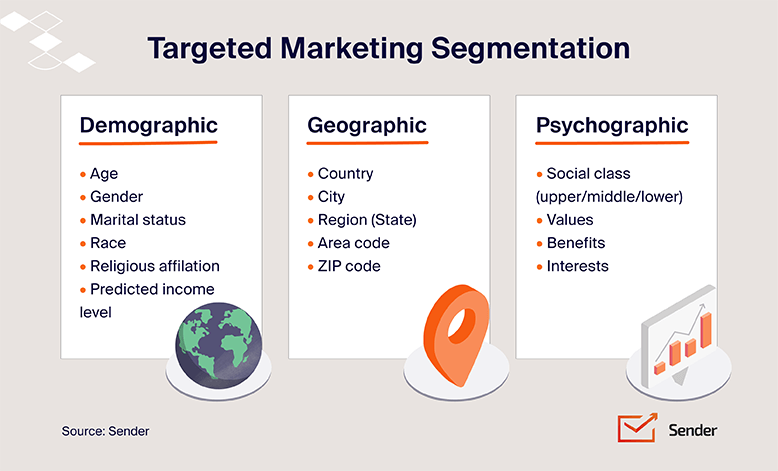
Build Long-Lasting Customer Relationships
Advertisers use demographic segmentation data to create targeted marketing campaigns, which helps to build long-lasting relationships with their customers.
Targeted ads often try to show the audience they’re targeting in the ad itself. For example, brands like Swiffer and Bounty target parents who often get stuck cleaning up their families’ messes. To do that, they show a mom or a dad as the main character in their commercials.
When a consumer relates to an ad, they instantly feel a greater connection to the brand. This connection is amplified when they see their wants, needs, or pain points in the ad, as well. The result is a more personalized experience that could lead to conversions.
Personalize your email newsletters and send targeted campaigns with Sender. It’s easy, effective & free.
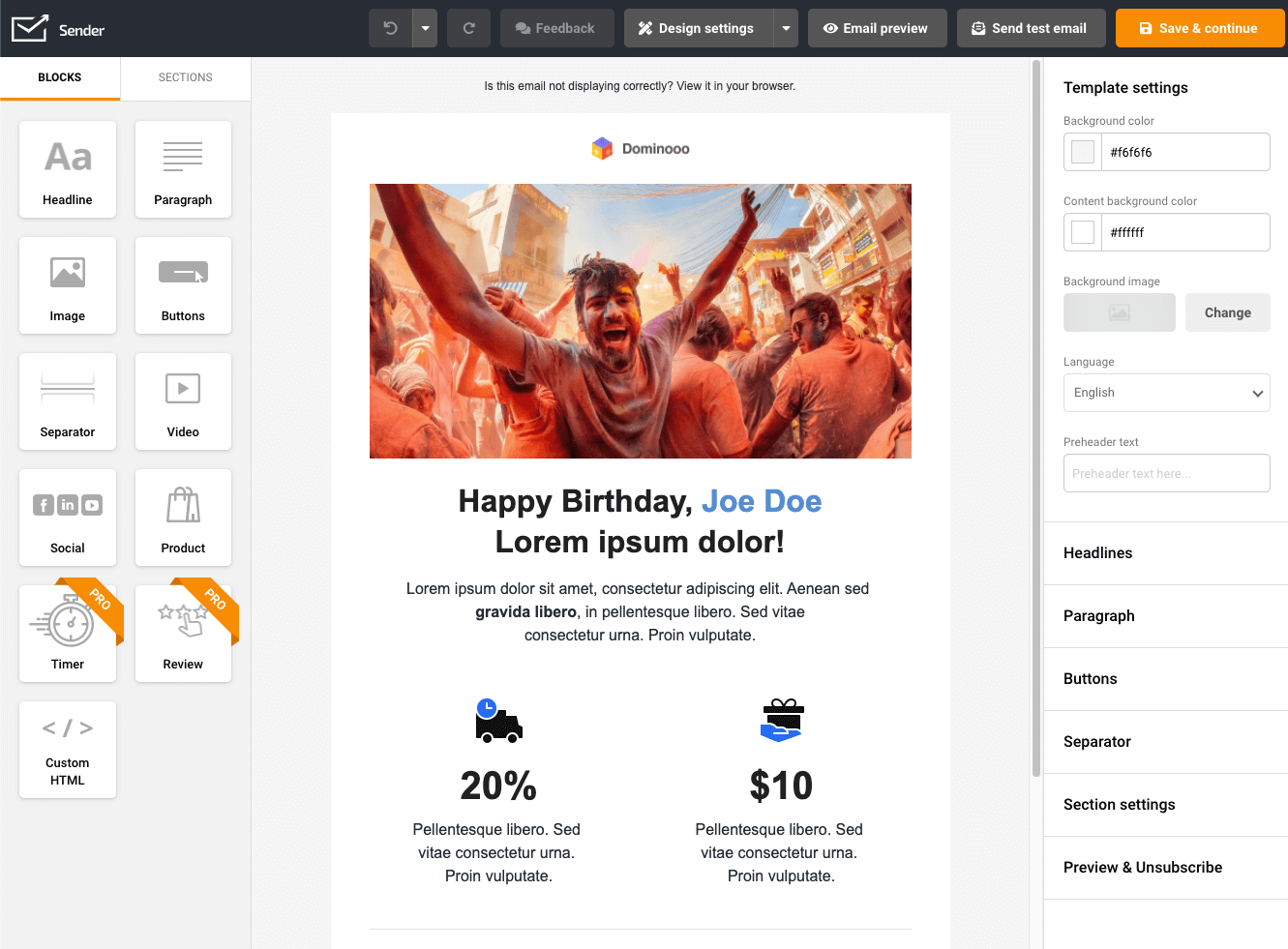
Personalized experiences are exactly what consumers are looking for in the modern age. According to Statista, 81% of Gen Z respondents said they liked ads that are tailored to them, and 52% of millennial-age respondents said the same thing.
When customers like their experience with a brand, they are more likely to feel loyalty toward that brand.
Demographic segmentation strategies tell you who that customer is, enabling you to craft that long-lasting relationship with them.
Improve Your Products and Services
Finally, demographic segmentation is important and beneficial because it helps you improve your products and services.
Take Taco Bell, for instance. In 2012, the popular fast food chain was struggling. Their old slogan, “Think outside the bun,” was just one of many elements of their marketing strategy that was no longer connecting with their primary audience: teens and 20-year-olds.
So, to attract the young crowd, they took the following steps:
- Updated their long-standing slogan to “Live Mas,” which means “live more” with a sprinkle of Spanish (apropos the Mexican-inspired cuisine).
- Updated their branding to look cleaner and more modern;
- Opened more upscale Cantina-style restaurants;
- Added fun new menu items like tacos made with Doritos;
- Became more proactive in building a funny, relatable social media presence;
- Built a lifestyle brand.

All their efforts at improving their business model paid off. Taco Bell is thriving today, with thousands of locations in the US and internationally.
The secret to their success was quite simple: they made key changes to their products and services to appeal to the modern younger demographic.
Curiosity piqued? Explore more in-depth analysis and diverse viewpoints on what is customer segmentation (definition & examples).
Demographic Segmentation Examples
In this section, we’ll cover real-life examples of demographic segmentation across five demographic segmentation factors: age, gender, income and occupation, ethnicity and religion, and family structure.
Age
Check out these two companies that are heavily based on age when they market products.
LEGO

LEGO has traditionally marketed their plastic building playsets toward children aged 3-12 years old. But in recent years, they’ve begun producing sets with a higher degree of realism and complexity to meet the demand of grown-up consumers.
Consumer Cellular
Consumer Cellular is a no-contract cell phone service targeted at seniors aged 50 years old and up. Both the service and the phones that the brand offers are designed to make staying in touch with their relatives easier for older, less technologically savvy people.
Gender
Next, we’ll look at a couple of brands that target segmentation based on gender.
SKIMS
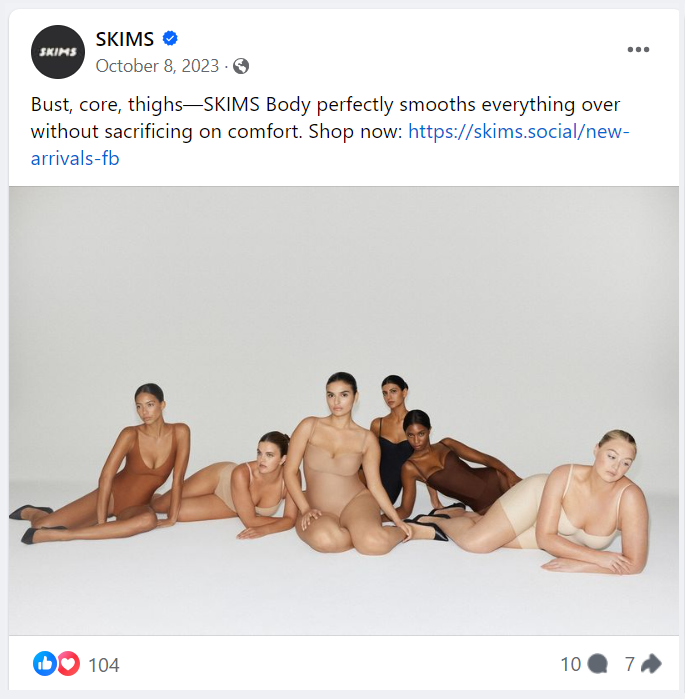
SKIMS is a shapewear brand founded by reality television star and celebrity influencer Kim Kardashian. The products offered are marketed toward women who want to achieve a tighter, more shapely figure under their clothing.
Hims
Hims is a telehealth service that provides medicated solutions to male-specific problems, like hair loss and ED. This company’s branding is discreet and unassuming, perfect for men who want to address their health concerns privately.
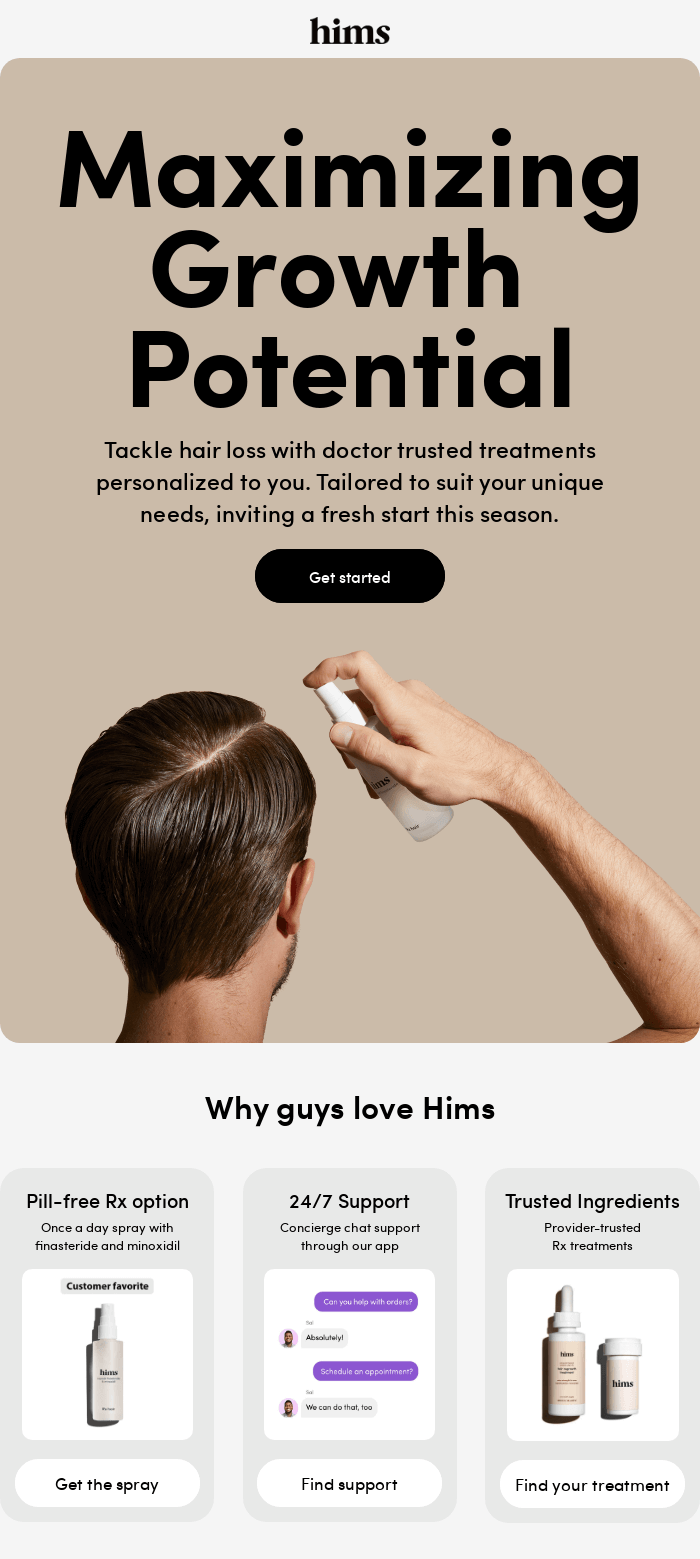
Income and Occupation
For our third segment, we’ll cover examples of segmentation based on income and occupation-targeting companies.
Temu
You may have seen Temu’s commercials during the 2024 Super Bowl. Temu is similar to Wish and Shein, and is more popular with lower-income consumers.
This website markets itself as a place to find whatever it is you’re looking for at the cheapest prices. It’s further reinforced by their catchy and very accurate slogan – “Shop Like a Billionaire”
Scrivener
Scrivener is a word processor designed with writers in mind. It provides outlines, document templates, organizational tools, and other features that appeal directly to authors, screenwriters, students, lawyers, and the like.
Ethnicity and Religion
Ethnicity and religion are both very sensitive segments to market toward but can be incredibly powerful when directed correctly. Let’s explore an example of each one.
Juvia’s Place
Juvia’s Place is a cosmetics brand that caters to all skin tones, but specifically the darker shades of people of color. It occupies an important place in the beauty industry, which still struggles with inclusivity in some areas.
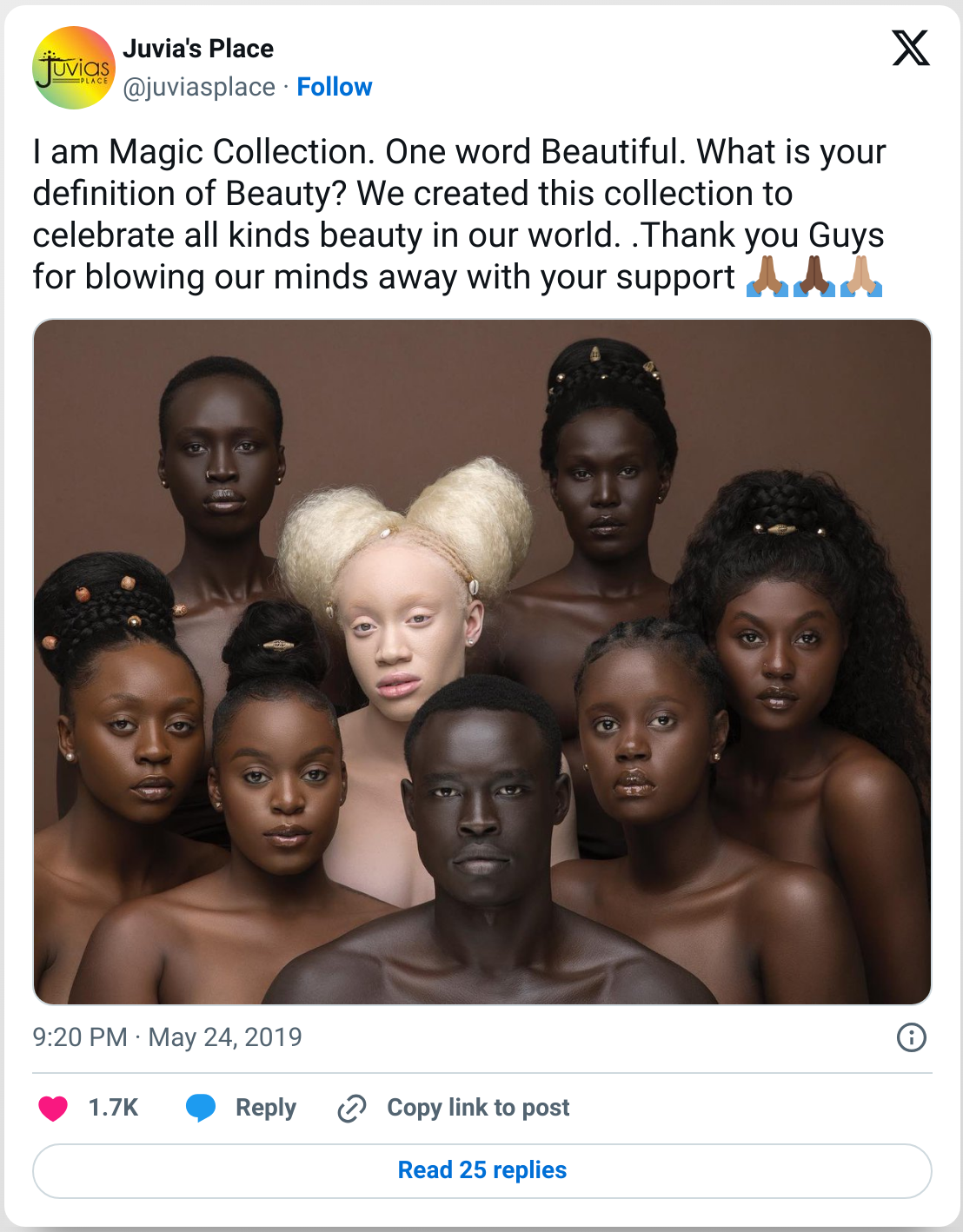
Mogen David
Mogen David is a wine company that has been the go-to brand for the American Jewish population since the 1900s. All their wine is Kosher, meaning that it’s suitable for use in Jewish ceremonies like the Sabbath and the Passover seder.

Family Structure
Finally, here’s a brand whose marketing strategies are based on family structure.
Walt Disney Company
Who remembers watching commercials for Walt Disney World or Disneyland when they were little?
In those ads, much like the ones they still air today, there would be at least one or two kids talking excitedly about going to the Most Magical Place on Earth. Then the scene would change to show the whole family together, smiling and having a wonderful time at a Disney park.
Clearly, the Walt Disney Company focuses on families as their target audience for their theme park advertisements.
Key Takeaways
We now come to the end of our guide to demographic segmentation. Here are your key takeaways:
- Demographic segmentation is the practice of grouping your target audience into segments based on their shared demographics;
- It’s the crucial first step to developing targeted and personalized marketing campaigns that convert;
- Some of the most common demographics that marketers use to segment are age, gender, income, occupation, ethnicity, religion, and family structure;
- Demographic segmentation strategies can eventually lead to more optimized marketing campaigns, long-lasting customer relationships, and improved products and services.
Before you click away, make sure to check out our recommended articles:
- What is Behavioral Segmentation: Definition, Types
- STP Marketing Analysis: Segmentation, Targeting, Positioning
- Target Market: Definition, Examples, Market Segments
Author’s bio
Alise is a content marketing manager at Setupad. Having worked in the AdTech industry for more than three years, Alise has developed a strong attention to detail and research, as well as a passion for technology.



